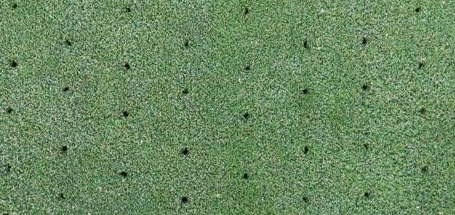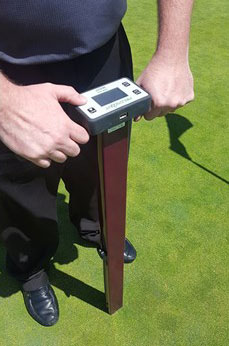It has been a long hot summer, and your turf is probably overdue for some fresh air. Air gas exchange is crucial for maintaining healthy turfgrass on putting greens, tees, and fairways year round, but it should be a top priority when the summer heat hits.
Time for a Deep Breath of Fresh Air
Simply put, your turf needs oxygen, water, nutrients, and drainage to establish a healthy root system and grow strong. Proper air gas exchange and practices such as turf aeration support the following, which are crucial for growing healthy turf:
- Oxygen Supply: Grass roots require oxygen for respiration. Adequate oxygen in the soil helps roots grow deeper and stronger.
- Carbon Dioxide Removal: Respiration by roots and soil microorganisms produces carbon dioxide, which needs to be removed from the root zone to prevent toxicity.
- Methane and Nitrogen Balance: These gasses can accumulate due to organic matter decomposition and other processes. Proper air gas exchange helps to maintain a balanced soil environment.
Factors Affecting Air Gas Exchange
Walking. Playing. Mowing. These all compact the turf and put stress on it. Even rain and irrigation can affect how your turf is compacted. And the more compacted your turf is, the less air and gas flow it’ll have. The pockets of air where roots can grow will diminish in more compact conditions, and with less space for roots to grow, the less healthy turf will be. Here are several conditions that might affect the air gas exchange of the turf:
- Soil Compaction: Compacted soil reduces pore space, limiting air movement. Aeration practices are essential to alleviate compaction.
- Soil Structure: Good soil structure with a mix of particle sizes (sand, silt, clay) promotes better air movement.
- Organic Matter: High levels of organic matter can clog pores, reducing air exchange. Regular topdressing and thatch management help maintain balance.
- Moisture Levels: Waterlogged soils have reduced air spaces, while very dry soils can also hinder air movement. Proper irrigation management is crucial.
Turf Aeration and Practices to Improve Air Gas Exchange
So, what can you do about improving the air gas exchange for putting greens, tees, and fairways on your course? Lots! Here are a few solutions that can help improve the conditions of your turf with better air and gas flow:
- Turf Aeration: Core aeration, spiking, and slicing are common practices to create channels for air movement.
- Topdressing: Applying a thin layer of sand or soil to the surface helps maintain soil structure and promote air exchange.
- Thatch Management: Regular dethatching prevents the buildup of organic layers that can impede air movement.
- Irrigation Management: Ensuring the soil is not overly wet or dry helps maintain optimal air exchange.
 How turf aeration looks after properly removing plugs of soil.
How turf aeration looks after properly removing plugs of soil.
 A close up of a turf aerator with its penetrating tines.
A close up of a turf aerator with its penetrating tines.
Monitoring and Management
How do you know if you need to change up your processes and workflow to affect air gas exchange on your course? It takes a combination of testing and inspection to formulate a proper strategy.

This is a moisture meter for checking moisture content in the greens daily.
- Soil Testing: Regular testing for compaction, organic matter levels, and moisture content helps in planning appropriate maintenance practices.
- Visual Inspection: Checking for signs of poor air exchange, such as shallow rooting or turf stress, helps in timely intervention.
- Professional Guidance: Consulting with turf management professionals can provide tailored solutions for specific putting green conditions.
Better Air. Better Greens.
Overall, maintaining good air gas exchange in putting greens is key to promoting healthy turfgrass and optimal playing conditions.




